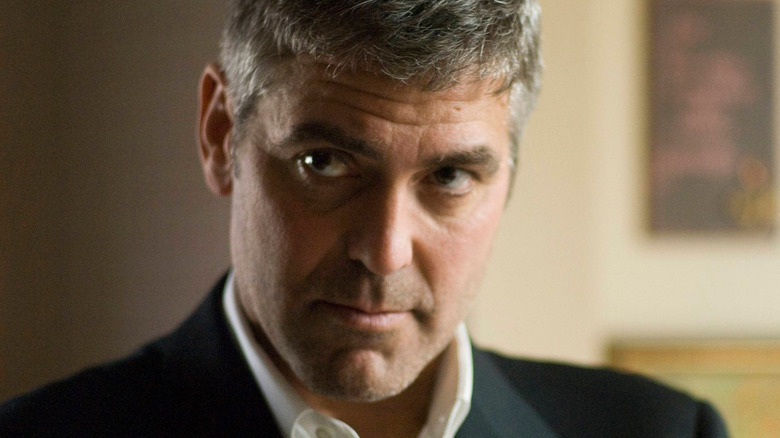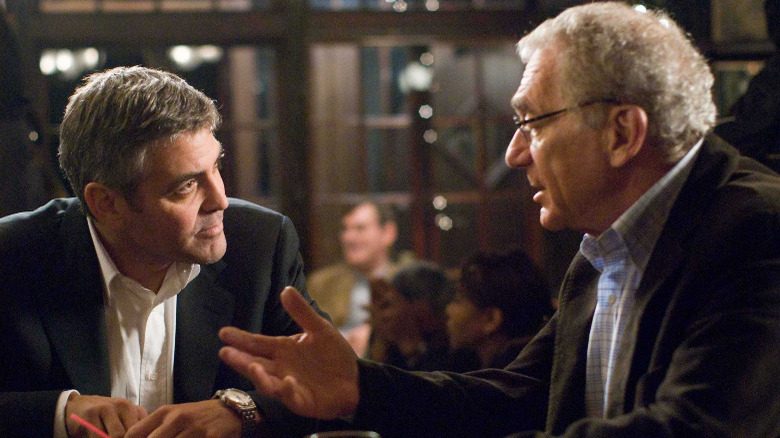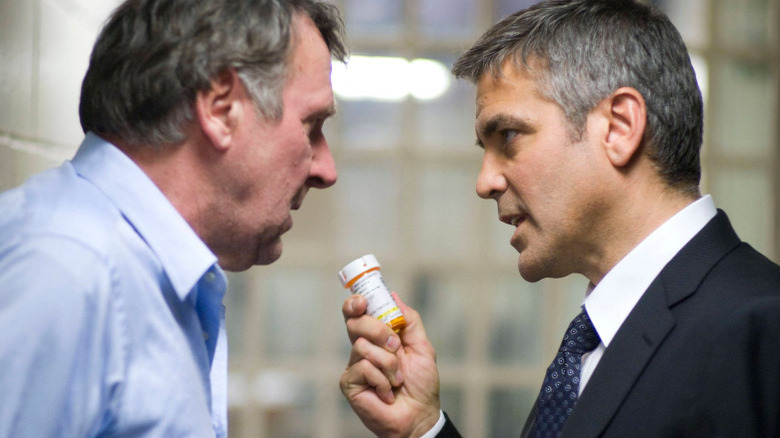How Michael Clayton Brought Filmmaking's Past Back Into The Present
We here at /Film often talk about the decline of adult-targeted mid-budget films at the box office and how they've been increasingly relegated to the world of streaming (which, to be fair, comes with its own perks), with big-budget movies taking up all the screens in theaters. This trend isn't anything new, either, having already begun well before Netflix changed the game by launching its streaming service in 2007.
Indeed, wind the clock back to 2007, and you'll find the box office was already being dominated by superhero films ("Spider-Man 3"), sequels ("Shrek the Third"), and big-budget movies based on lucrative IPs ("Transformers"). Original "Bourne" film trilogy co-writer Tony Gilroy was all-too-aware of this fact when he made his directorial debut on that year's "Michael Clayton," a legal thriller starring George Clooney as the titular character, a morally-flexible "fixer" for a powerful law firm. Tilda Swinton and Tom Wilkinson also star in the movie opposite Sydney Pollack, himself the director of similarly adult dramatic thrillers like "Three Days of the Condor" and "The Firm."
'70s movies combine 'muscular filmmaking with great subject matter'
In an October 2007 interview with Filmmaker Magazine, Gilroy cited Pollack's 1970s thrillers (which include "Three Days of the Condor" and "The Yakuza") and like-minded '70s genre fare as a heavy influence on not just "Michael Clayton" but his love of films in general. He explained:
"'70s movies are the heart of where my moviegoing obsession really began, and they're still the films I go back and look at the most. It was a combination of muscular filmmaking with great subject matter. And ambiguity. Muscle and ambiguity and complexity and loose ends. That's been ghetto-ized off to the side now to the Sundance film or the super-indie film, where people are really hanging on for dear life [because] they don't have enough money to make their movies. They have the twentieth choice of actor, and their crew's doing everything for the first time.
"But that era of balls-out, tough, full-stop, pro moviemaking that didn't have the chaos beaten out of it, there are so many movies that fall into that category: the [Alan J.] Pakula films, Klute was a big influence, 'Point Blank' was a huge influence, all the Gordon Willis films, Sidney Lumet, Hal Ashby, Frank Perry – and Sydney [Pollack]."
"Michael Clayton" very much embodies the qualities Gilroy admires most about '70s thrillers. It's a tense, slow-burn affair that starts with a literal bang when Michael avoids being killed by a bomb in his car through sheer luck, only to jump back in time four days and unravel the tangled web of events that led to this attempt on his life. Mind you, "Michael Clayton" did this well before opening in medias res became an overused trick that movie or TV thrillers use to quickly try and hook their audience. By comparison, the shocking prologue to Gilroy's film is much more effective at hanging the proverbial Sword of Damocles over its lead's head.
'I'm not the guy you kill, I'm the guy you buy!'
Besides emulating the mood of '70s thrillers, "Michael Clayton" shares their grittier visual style, as well as their knack for blending social commentary with storytelling. The movie follows Michael as he tries to salvage his firm's defense in a multi-year, billion-dollar class-action lawsuit against a conglomerate that (knowingly, as Michael is aware) sold a cancer-causing weed killer, all the while dealing with a massive debt caused by a failed business venture with his brother. Far from a put-upon savior, Michael is driven by self-preservation for most of the film, to the degree that you begin to wonder if he will, in fact, do the right thing in the end.
Shady protagonists of this variety were around in films long before the '60s (when "Point Blank" came out) and '70s, obviously, going back to the noir dramas and thrillers of the '40s and '50s. Gilroy also cited these movies as an influence on "Michael Clayton," explaining:
"Growing up, it was all the films of the 60s. 'It's a Mad, Mad, Mad, Mad World' was a huge influence on me. But when it came to going to movies in the 70s, that's really when everything [came together]. I moved to Boston when I was 17 years old as a musician, and there was the Orson Welles, the Harvard Square, the Brattle Theater, the Central Square Theater — within 15 blocks, there were five or six amazing rep houses that were changing movies every day. Imagine if there were 18 Film Forums. I used to see everything, and then I started working back and seeing all the Billy Wilder films, the old [Ernst] Lubitsch films. So those were the years that I really fell in love with movies."
As successful as "Michael Clayton" was (turning a tidy profit while snagging Swinton an Oscar), it didn't do nearly well enough to usher in a new era of older-skewing thrillers, much less change the tide when it comes to mid-budget movies. For his part, Gilroy has adapted to the times, lending his old-school sensibilities to the "Star Wars" franchise by co-writing "Rogue One: A Star Wars Story" and the upcoming "Andor" series. But if anything, that's made "Michael Clayton" feel all the more unique in the way it brought Hollywood's past into the present, 15 years ago.


